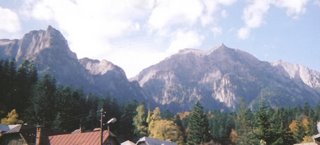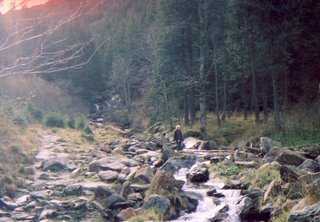Lake Snagov,
Snagov Monastery,
Burial, Possible once, Vlad III Tepes
Complex Astoria
Approach Romania with a view to history that can be corroborated, and history-stories that cannot, but carry weight. Then find that the parts that cannot be corroborated, take on an independent fictional existence. Enjoy them all, but vet. With so many images of Vlad III Tepes, Vlad the Impaler, it takes conscious effort to approach his biography with detachment, see Vlad III Tepes, see See
http://www.pitt.edu/~slavic/courses/vampires/images/vlad/vlad.html.
1. Lake Snagov. Is, or was, all or part of Vlad III Tepes buried here. Row out, from the summer hub, Complex Astoria, to find out. That is the only access. Early morning is lovely.
.
 Lake Snagov, Romania. Row to monastery from Complex Astoria
Lake Snagov, Romania. Row to monastery from Complex Astoria
Complex Astoria is a traditional resort area now, and about 18 miles from Bucharest, and built during the communist era for the elite. It looked like a perfect first destination from the guidebook, but it did not mention that closes well before we were to arrive in the area, in October There were caretakers about, and others, so we were given a nice room. See FN 1
2. Snagov Monastery:
The only way to get to the island monastery,
and the alleged burial place of Vlad;s body (the claim) is by rowboat.
Strong young men at Astoria will do the rowing. Leave plenty of time.
Transport to the island is by rowboat. Go fast, before all this changes
to motor launches and noise. See it at
http://www.bootsnall.com/travelstories/europe/nov03vlad.
It was built in the 1300's, see
http://felixromania.com/sights/wallachia/snagov/ Bones were found at a doorway and elsewhere here, some human and some elegant fabric, but there can be established no connection to Vlad, and some apparently there also were animal (chicken) bones. Apparently
he is not there any more. The story tells that he was moved (his body -
the head was decapitated during battle) to the outside, by the door, to
protect it. Then, when places were dug up to find him, there was no
sign -- only chicken or other animal bones. Was the head taken elsewhere.
.
There are records that he had once been buried in the church.
There was a printing press here in the 1700's, but then the place became disused, then used as a prison, and eventually, renovations began sporadically, up to 1995 or so.
.
At the small church on the island, it is pay to play. A priest takes entry tickets
to the interior spot in front of the altar where Vlad is said to be
buried. See
http://www.draculas.info/gallery/picture_of_monastery_of_snagov_vlad_the_impaler_grave-12/ This site looks like a Romanian offering an overview, to be preferred over the tourism sites, see
http://dracula-transylvania.blogspot.com/2008/04/snagov-monastery.html/
The interior is lovely, even if set for tourists. One novel, "The Historian," by Elizabeth Kostova, see
http://www.bookbrowse.com/reviews/index.cfm?book_number=1589
focuses at one point on where the head might have gone, then the body,
and by whom, and what happened to the parts next. Are all
reunitings good things? See and speculate about the stories at
http://www.castleofspirits.com/vlad. - Vlad tales.
.
One novel, "The Historian," by Elizabeth Kostova, see
http://www.bookbrowse.com/reviews/index.cfm?book_number=1589
focuses at one point on where the head might have gone, then the body,
and by whom, and what happened to the parts next. Are all
reunitings good things? See and speculate about the stories at
http://www.castleofspirits.com/vlad. - Vlad tales.
.
....................................................
FN 1 Complex Astoria
.
Overnight. This had been a communist resort, still is a resort, see
http://mapcarta.com/28166480. Use your translator at
http://www.tourismguide.ro/tgr/complex_astoria_snagov_1778.php. Beware that it is seasonal. This was October, and just past the tourist season. More at
http://www.world66.com/europe/romania/snagovlake. It was already in process of closing until spring completely, and we were the only guests there. Nervous? Why. It's too late to go elsewhere, we don't travel fancy, our backpacks are all we have, and without faith in human nature no travel is worth it anyway. When the door would not lock, we stuck a chair under the knob as seen on TV. Done.
.
There are many campsites and chalets at the resort. The main building is a large hotel with atrium, long halls with rooms. Just fine. Back to locks. Check that you know how to work the locks before accepting the room and unpacking. They are not the same as ours. May take several turns. As it turned out, ours would have locked if we just kept turning, and turning.
.
Timing an arrival somewhere:
.
If you find yourself in a place without restaurants or hotels, as here (we finally found the Complex) just stop at the nearest Magazin Mixt - at the nearest crossroads - convenience store - and make a picnic. Sit outside and eat, and just be friendly. Lots of horsecarts, people, children.
FN 2
Roma in Romania:
- Roma constitute 10% of the Romanian population, see Central Europe Review at http://www.ce-review.org/00/41/dragomir41.html.
In Romania, they were originally brought in as slaves in medieval
times, and are now dismissed and discriminated against as disruptive,
criminal, etc. Read the Central Europe Review site above, CER. See
also Gypsies, Roma, Romani. The US and other western countries follow suit. See http://sciway3.net/clark/freemoors/roma.html.
- Is Presidential Candidate Romney the inheritor of a Roma surname
from a century ago, before becoming Mormon? Possibly. There were no
Mormons before 1820 --Joseph Smith, see http://historyofmormonism.com/,
so Romney had to be something else. Our names come from somewhere.
Even if he knows he comes from Roma roots, or has any interest even if
he specifically doesn't, is he different in now ignoring them. Do any
of us take ethnicity so seriously that we promote the group's thriving
when we rise above? See speculations at http://joyofequivocating.blogspot.com/2011/10/deny-thy-father-romney-as-roma-other.html. Go check. Ancestry.com can help.
For any candidate in any country for any substantial elected
office: what have you done to promote the well-being of the Roma
population in your borders? Education? Structures? Jobs? Health?
2. Snagov Monastery: The only way to get to the island monastery,
and the alleged burial place of Vlad;s body (the claim) is by rowboat.
Strong young men at Astoria will do the rowing. Leave plenty of time.
Transport to the island is by rowboat. Go fast, before all this changes
to motor launches and noise. See it at
http://www.bootsnall.com/travelstories/europe/nov03vlad.
.
The Monastery:
.
.
There
is a small church on the island, with a priest taking the entry tickets
to the interior spot in front of the altar where Vlad is said to be
buried. See
http://www.draculas.info/gallery/picture_of_monastery_of_snagov_vlad_the_impaler_grave-12/ This looks like a Romanian offering an overview, to be preferred over the tourism sites, see
http://dracula-transylvania.blogspot.com/2008/04/snagov-monastery.html
.
Apparently
he is not there any more. The story tells that he was moved (his body -
the head was decapitated during battle) to the outside, by the door, to
protect it. Then, when places were dug up to find him, there was no
sign -- only chicken or other animal bones.
.
Still, there are records that he had once been buried in the church.
.
 Lake Snagov, Romania. Row to monastery from Complex Astoria
Lake Snagov, Romania. Row to monastery from Complex Astoria Monastery, Lake Snagov, perhaps burial place of Vlad III Tepes, Vlad the Impaler
Monastery, Lake Snagov, perhaps burial place of Vlad III Tepes, Vlad the Impaler Snagov Monastery, Lake Snagov, Romania. Interior. Alleged Vlad burial
Snagov Monastery, Lake Snagov, Romania. Interior. Alleged Vlad burial Bran Castle, Brasov, Romania
Bran Castle, Brasov, Romania Bran Castle, Brasov, Romania
Bran Castle, Brasov, Romania Bran Castle, Brasov, Romania
Bran Castle, Brasov, Romania Rasnov Citadel, Romania
Rasnov Citadel, Romania Teutonic Knights, Grand Masters, Malbork, Poland
Teutonic Knights, Grand Masters, Malbork, Poland Rasnov area, Romania. Cows of the household
Rasnov area, Romania. Cows of the household Sinaia, Peles Castle, Romania
Sinaia, Peles Castle, Romania Curtea de Arges, Monastery, Romania
Curtea de Arges, Monastery, Romania Dan Widing at Poinari Citadel, Vlad Dracula's castle ruin, Transfagarasan Pass, Carpathian Alps, Romania
Dan Widing at Poinari Citadel, Vlad Dracula's castle ruin, Transfagarasan Pass, Carpathian Alps, Romania Poinari Castle, Poinari Citadel, peak, at left, Transylvania, Romania
Poinari Castle, Poinari Citadel, peak, at left, Transylvania, Romania  Dan Widing climbs path to Poenari Citadel, Castle, Vlad Tepes, Romania
Dan Widing climbs path to Poenari Citadel, Castle, Vlad Tepes, Romania View from Poenari Citadel, Castle ruin, Vlad Tepes, Romania
View from Poenari Citadel, Castle ruin, Vlad Tepes, Romania Dan Widing with guide at Poienari Citadel, Vlad Fortress, Romania
Dan Widing with guide at Poienari Citadel, Vlad Fortress, Romania Dracula Rooming House, a Pensione, Arefu, Romania
Dracula Rooming House, a Pensione, Arefu, Romania Carpathian Mountains, Transfagarasan Pass, Romania
Carpathian Mountains, Transfagarasan Pass, Romania Transfagarasan Pass, midday hike, Romania
Transfagarasan Pass, midday hike, Romania Naver, tradesmen, Sibiu, Romania
Naver, tradesmen, Sibiu, Romania Sighisoara, birthplace of Vlad Tepes, Romania
Sighisoara, birthplace of Vlad Tepes, Romania